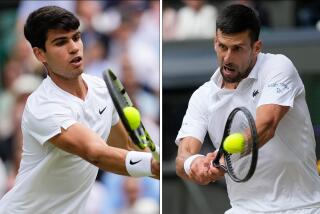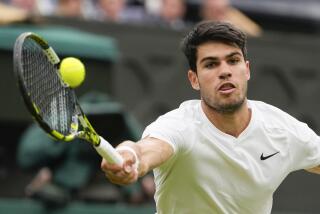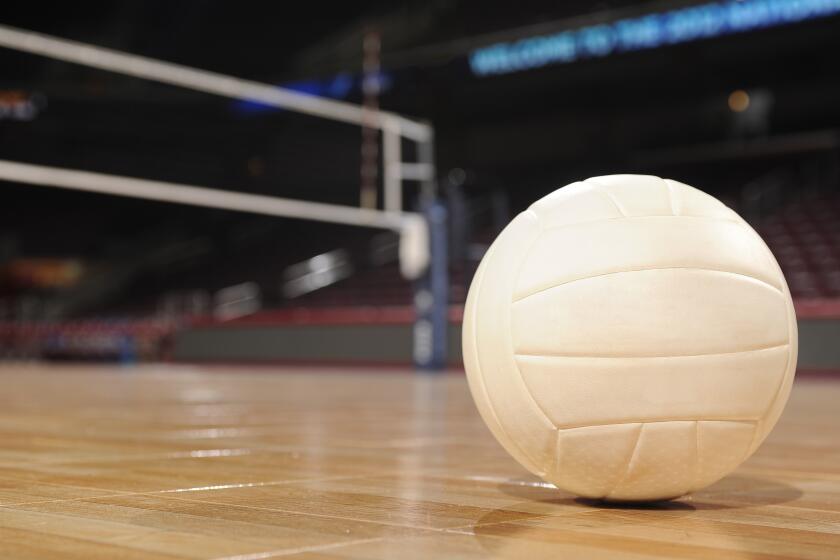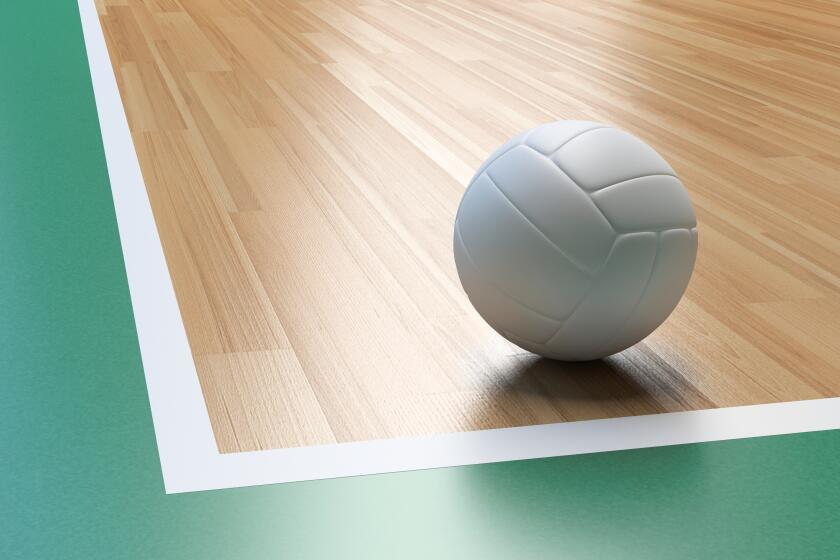Williams and Capriati Get Sand Kicked in Faces
- Share via
Jennifer Capriati stood on the steps leading to the stadium court at the Manhattan Country Club in Manhattan Beach, watching something quite rare unfold on Friday afternoon. Serena Williams, inexplicably, was going to lose a match. Then Capriati followed in Williams’ steps.
In a little more than an hour, the JPMorgan Chase Open lost its top-seeded player, the reigning French Open and Wimbledon champion--Williams--and the second-seeded Australian Open title holder, Capriati, both in the quarterfinals. Together, Chanda Rubin and Ai Sugiyama of Japan took out the 2002 Grand Slam.
Rubin has defeated a No. 1-ranked player before but this meant more considering Williams’ dominance of women’s tennis. The 12th-seeded Rubin defeated Williams, 6-2, 4-6, 7-5, in 2 hours 8 minutes, rallying from a 4-1 third-set deficit. It ended Williams’ 21-match winning streak.
Sugiyama’s upset was not as dramatic but more decisive. The 27-year-old beat Capriati, 6-3, 6-3, in 56 minutes.
In today’s semifinals, Rubin will face No. 4 Jelena Dokic of Yugoslavia, and Sugiyama will play No. 3 Lindsay Davenport, who defeated Eleni Daniilidou of Greece, 7-6 (2), 6-2. Dokic defeated Rita Grande of Italy, 6-4, 6-1.
Though her last victory against Capriati was in 1998, Sugiyama was not intimidated. In fact, the Rubin result gave her motivation. She, too, stood on the steps and wanted to follow Rubin’s lead.
“I think so. She does it. OK, now my turn. I can also do it,” Sugiyama said.
Capriati, 26, said her tough third-round match Thursday night affected her. But Sugiyama’s doubles match did not finish until nearly 11:30 Thursday night. Those who watched Capriati practice before her match had a feeling she was ripe for an upset, based on her crankiness and ragged play.
“She just keeps going at you. I was a little bit flat, wasn’t moving as well as I’ve been,” said Capriati, who hasn’t gotten past the quarterfinals of any tournament since taking the first set against Williams in the French Open semifinals. “I was missing a lot of easy shots I haven’t been missing.”
Williams, on the other hand, made her usual array of spectacular shots, sprinkled with some wild unforced errors, particularly on the forehand side. The loss didn’t seem to concern her.
“This isn’t a setback,” said Williams, who lost here last year in the quarterfinals after holding six match points against Monica Seles. “I’m still No. 1. I still plan on getting that Open [title]. So it doesn’t really matter to me. I would have liked to have won the match, but I don’t think of this as a setback at all.”
Williams, 20, had a few rough moments during the 21-match winning streak that took her from Rome to Paris to Wimbledon to Manhattan Beach. If she faltered early, Williams always would finish strongly. It was almost as though she was offended by losing a set. Granted, this happened just three times in the 21 matches.
So when Rubin won the first set, it seemed natural to brace for the imminent onslaught. And it came, Williams taking the second set and a 4-1 lead in the third. But Rubin was different from the others. She didn’t go away and was not intimidated by the sound and fury of Williams’ grunts and groundstrokes. Rubin, 26, calmly kept at it, quietly chipping away at the lead, playing almost in silence. She is a case study in persistence, having had two knee surgeries, the most recent, in January, keeping her out of action until the clay-court season.
The soundtrack was Williams’ alone. Her screams of “Come on!” ranged from fiercely competitive to angry to hopeful. The last time she had lost a match was in May against Justine Henin of Belgium in the final at Berlin on clay in three sets.
For a time, it appeared as though Rubin might pull off the win in straight sets. She led, 4-2, in the second set and had points to take a 5-3 lead but dropped her serve, losing a 40-0 lead. Williams won the second by taking 11 of the last 12 points.
Did Rubin feel it had been a lost opportunity?
“That’s an understatement, up 40-0 and looking at returning and then having the chance to serve for the match,” Rubin said. “She started playing much better and started hitting the shots, crazy shots with pace, and I made it tough for myself. I was kicking myself for a while in that third set. It was just a question of getting back to the game plan and fighting through the end of the match.”
But Rubin has been through these matches before. She beat Martina Hingis, then ranked No. 1, at Indian Wells in 1999 and played the longest women’s match at the 1996 Australian Open, winning, 16-14, in the third set against Arantxa Sanchez-Vicario in a quarterfinal.
On Friday she broke Williams at 30 in the 11th game of the third set when Williams hit a forehand into the net. In the last game, Rubin hit a superb lob winner to go up, 30-15, and Williams showed a rare flash of irritation, bouncing her racket. Two points later, Rubin secured the biggest victory of her career when Williams netted a backhand.
“I don’t feel my practices were up to par,” said Williams, 38-4 this year. “I couldn’t get the rhythm in practice, so I think it just kind of transfers subconsciously to your match.”
Rubin laughed when asked about the accomplishment of beating a Williams sister. “It’s a tough undertaking for sure,” she said. “Every Grand Slam, I think that’s really the stage you want to beat them on. This is a great step for me, winning that match and playing well enough to win the match.”
More to Read
Go beyond the scoreboard
Get the latest on L.A.'s teams in the daily Sports Report newsletter.
You may occasionally receive promotional content from the Los Angeles Times.











